Grade Level
6 - 8
minutes
45 to 90 minutes
subject
Life Science, Engineering and Tech
stem practices
Asking Questions and Defining Problems, Developing and Using Models
Activity Type:
After School Activity, Engineering design challenge, STEAM, Family activity
This activity is part of Science Friday’s Down to Earth program.
Eating on the International Space Station (ISS) can be challenging. The weight of the food is extremely important. It costs NASA $10,000 to transport one pound of food to the ISS. In order to maximize the amount of food it can ship, the food is freeze-dried to remove all the water and reduce the weight. Once it’s freeze-dried, the same one pound of food weighs only one ounce. The price to transport it now is $660. That’s a big savings!
In addition to being compact and lightweight, the food must also be tasty and nutritious. NASA nutrition has come a long way since the days of cubes and tubes, but what about food like tomatoes? Peppers? Or lettuce? Those don’t taste the same or feel the same in your mouth when they are dehydrated, and it can take three months for fresh food supplies to be delivered to the ISS. That problem will only get harder as space exploration expands to the moon, Mars, and beyond.
To solve this problem, NASA has created technology to help astronauts grow their own food—like peppers and lettuce—in space. What’s more exciting is that the same technology has the potential to help people on Earth. If you were a food scientist, what systems would you design to help with global food insecurity?
The Most Unusual Laboratory (Not) on Earth
Learning From Ancient Agriculture
When scientists began to tackle the huge challenge of growing food in microgravity, they turned to the past for a solution. Often, ancient people faced similar challenges and came up with innovative solutions. Astronauts were not the first people to try growing food in an area with limited water, light, and space. Over 800 years ago, the ancient Incas developed terrace farming to grow their crops on the sides of mountains, because they had lots of flat land without access to water. That technology provided the seed of ingenuity that led to the unique growing environments on the ISS today.
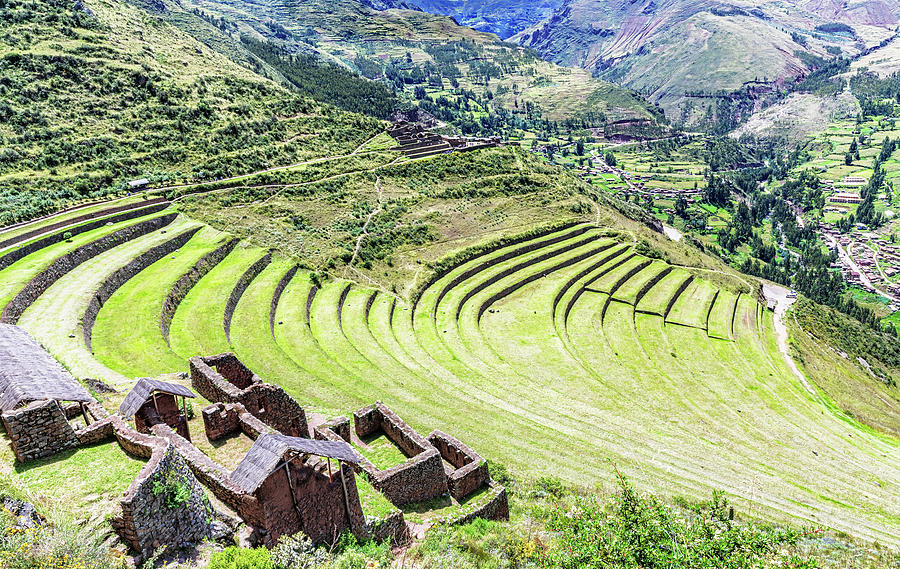
Plants Need Five Things To Grow
Whether in space or on Earth, plants need the same five basic things to grow: atmosphere, sunlight, water, nutrients, and temperature. Most places on Earth have all of these conditions, but on the ISS, an artificial environment needed to be created for plant growth.
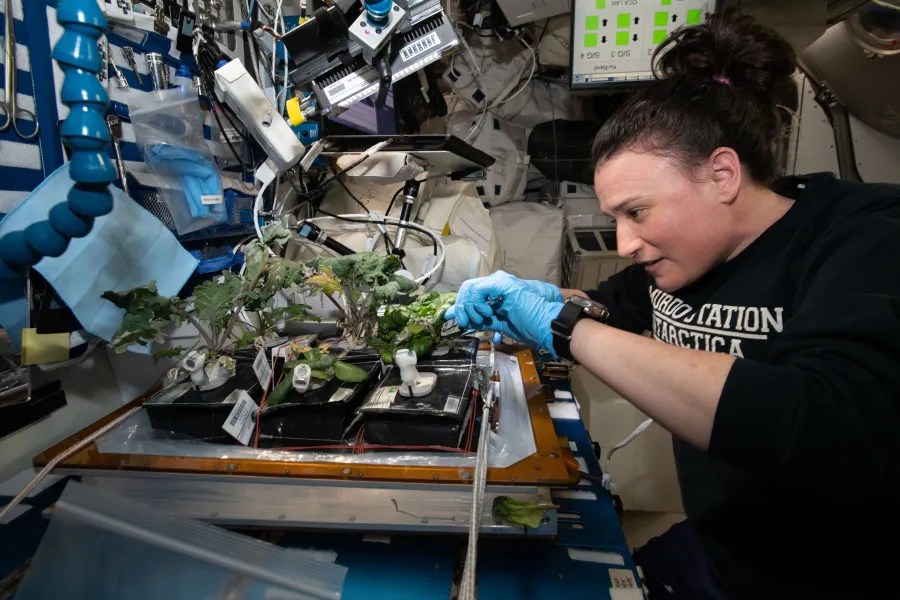
Enter Veggie, also known as NASA’s Vegetable Production System. Inside Veggie, seeds grow in plant pillows which contain a clay-like substance and slow-release fertilizer to feed the future plants. Within the pillows, the seeds are attached to wicks that absorb water to keep the seeds hydrated and direct their roots downward. LED lights, of red and blue wavelengths, shine overhead to encourage photosynthesis, which causes plant growth. Veggie requires astronauts to tend to the crops, just like farmers do on Earth.
Improving Technology To Grow Plants More Efficiently In Space
With the success of Veggie, scientists were eager to develop more efficient ways to grow food in space that reduced the time, energy, and space needed for plants. They developed the Advanced Plant Habitat (APH), a closed-loop, or enclosed, system for growing food, which was installed on the ISS in 2018. The APH does not require the astronauts to care for the plants, but instead it uses 180 different sensors that monitor and control temperature, light, water concentration, and overall plant health—all on its own!
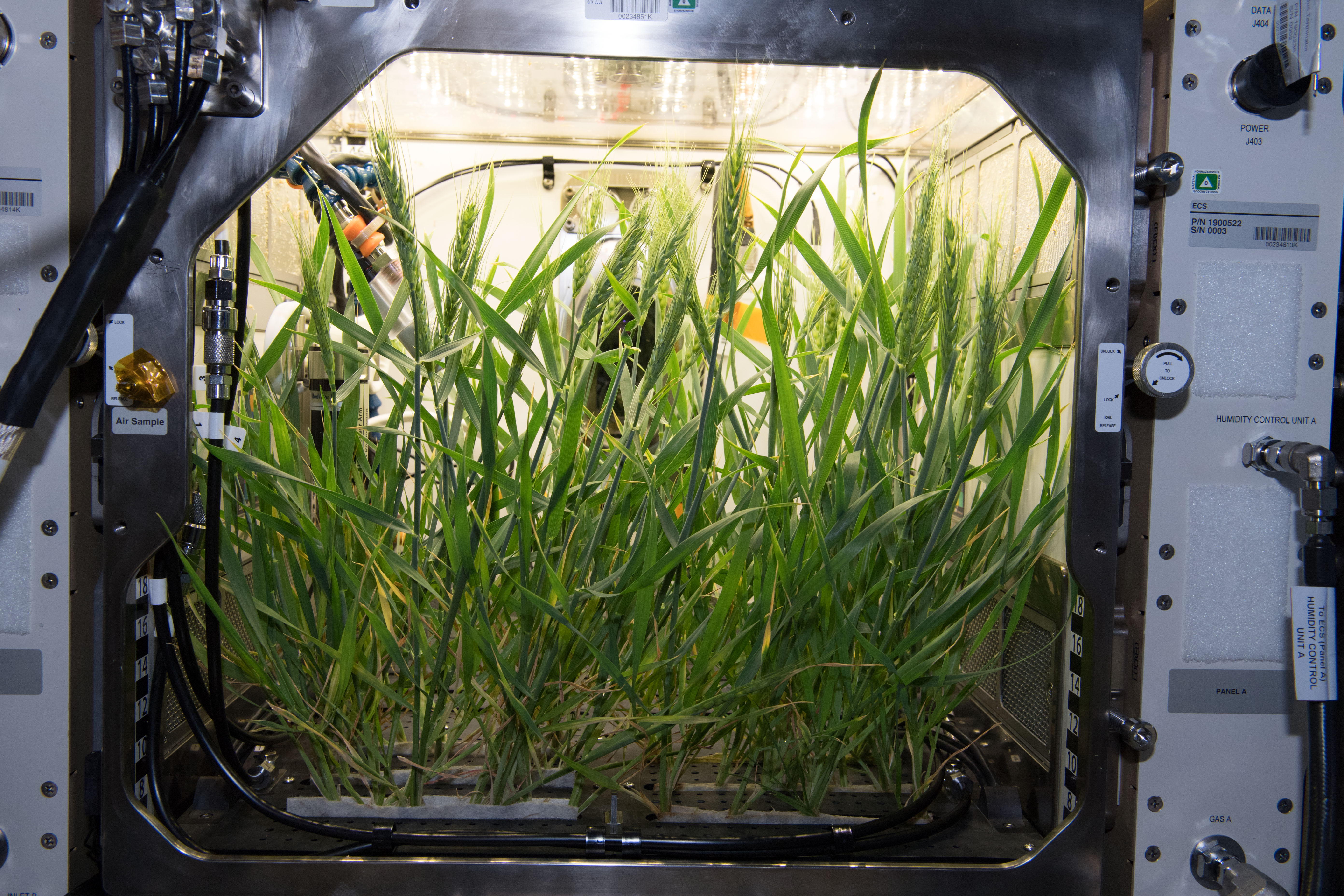
As the possibility of humans living on the Moon becomes more likely, scientists are realizing that growing plants without any sort of soil or solid medium is absolutely necessary. Why? NASA is still trying to figure out how to grow plants in the Moon’s rocky soil. To meet this challenge, NASA developed the eXposed Root On-Orbit Test System (XROOTS) and installed it on the ISS in 2022. XROOTS, unlike Veggie and APH, does not use solid growth media, like clay. Instead, it is designed to use water or air in the form of a hydroponic or mist-based aeroponic system. The roots float freely in the environment and receive periodic sprays of a nutrient solution.
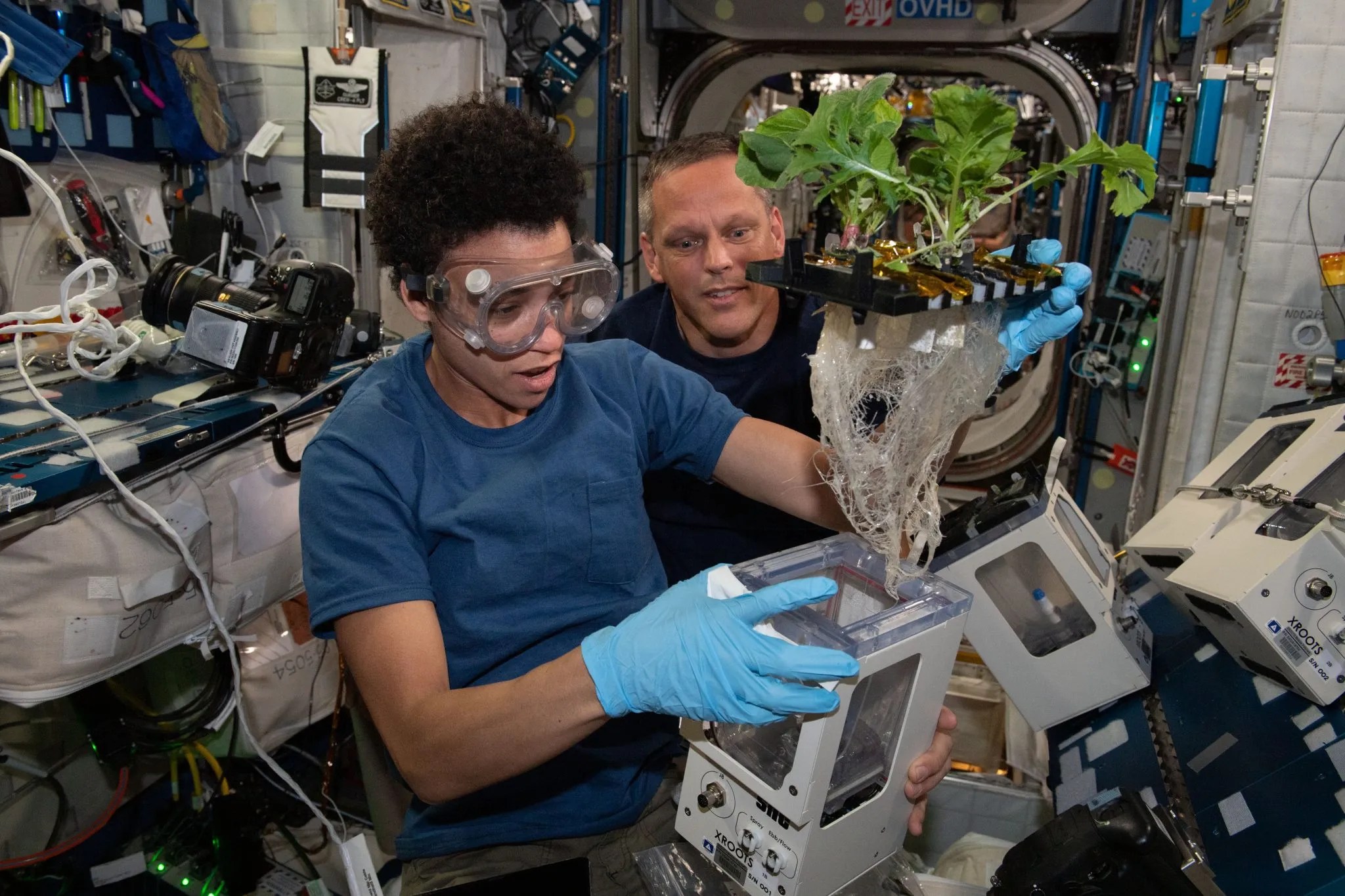
Create A Simple Hydroponic Planter
You can test how well different seeds could work in space by making a simple hydroponic unit using household materials. Pick vegetables or herbs that you’d want in space. If possible, plant different types of seeds to see which ones grow best in your planter. Or, if you’re working with a group, have each person try a different type of seed.
Materials
- Mission Cosmic Crops Worksheet
- Disposable water bottle with cap
- Aluminum foil
- Plastic wrap or a sandwich bag (if reusing a bag, make sure it is clean and dry).
- Rubber band
- Cotton sock
- Clean gravel or stones
- Vegetable seeds such as lettuce, spinach, cucumber, or beans or herbs like basil or dill
- Growing media such as rock wool, coconut (coco) coir, peat moss, perlite, or vermiculite
- Hydroponic nutrient concentrate, compost tea, or diluted fertilizer
- Water
- Scissors
- Ruler
- Awl or screwdriver
Build The Planter
- Start by measuring about 2 ½ inches from the top of the bottle. Mark it. Use your scissors to cut off the top of the bottle. The bottom of the bottle will be a reservoir for your nutrient solution. The top will hold the growing media and seeds.
- Use the awl (or a Phillips screwdriver) to pierce a hole in the center of the cap.
- Cut a strip from the bottom section of the sock that is between ½ inch and 1 inch wide. The length should be approximately as long as the bottom section of the bottle.
- Tie a knot in one end of the strip of fabric, about 2 inches from the end.
- Push the unknotted end through the hole you made in the cap so that the knot is on the inside of the cap. If needed, widen the hole to allow the strip to pass through, but take care not to widen it so much that the fabric falls out of the cap.
- Place the cap back onto the neck of the water bottle.
- Place some gravel in the bottom of the water bottle—the nutrient reservoir. The rocks will help keep your planter from falling over.
- Mix your nutrient solution and add it to your reservoir. Do not fill it all the way.
- Cover the reservoir with aluminum foil to keep the nutrient solution from being degraded by sunlight and to prevent the growth of algae.
- Invert the top of the bottle and place it on the reservoir so that the wick hangs down into the nutrient solution. You may need to trim your wick if it’s too long.
- Fill the inverted top of the bottle with growing media, leaving some space between the top of the media and the rim of the bottle. Be sure that the tail from the knot of your wick extends into the growing media, to help wick the nutrients from below.
- Add your seeds. Consult the seed package or a gardening guide for the amount to plant.
- Gently sprinkle some of your nutrient solution over the growing media.
- Place plastic wrap (or sandwich bag) over the top. Hold it in place with a rubber band if needed. The plastic creates a greenhouse effect, keeping the growing media warm and moist while the seeds germinate. Once the first green leaves appear, remove the wrap.
- Place your planter in a sunny spot and let the plants grow. Check the reservoir every week to make sure it doesn’t run dry. Make sure the plant media doesn’t dry out.
As your plants grow, consider:
- What plants seem to grow best in your hydroponic planter? What may be some reasons they grow well in this environment?
- How can you adapt this design for a larger plant, like a tomato?
- How can you improve upon your planter? What can you do to improve the plant growth or make the planter easier to use?
- Are there other types of media or nutrients that might be better for the types of plants you want to grow? Research hydroponics to learn more about successful growing techniques and try them to improve your results.
How Growing Food In Space Can Help On Earth
Our world is facing a huge food crisis. The technology developed to grow food in the difficult microgravity environment can be a great help to places on Earth that are not very good for growing food.
Food insecurity is an issue for many people who live in ecosystems that don’t support farming due to floods, droughts, and other weather patterns affected by climate change. The USDA defines the term food security as “access by all people at all times to enough food for an active, healthy life.” Poverty, high food prices, living in areas with unstable governments, or even in cities where it’s difficult to get affordable fresh food, are all factors that affect food security.

Creating greenhouses and hydroponics systems like the ones on the ISS might help with these issues. If greenhouses could be engineered to use limited supplies of water and soil, and provided with adequate sunlight, perhaps enough food could be grown to fulfill local needs. Additionally, plants bred to withstand the challenging microgravity environment in space can survive without much light, soil, or water. Those same conditions exist on Earth, so some types of sustainable space plants may be better suited to the changing climate on Earth.
Making A Meal Fit For An Astronaut
You Are The Future Of Food
Food is one of the most valuable resources on our planet. You could argue that it’s even more important than fossil fuels, which humans use for energy to power their homes, cars, and businesses. According to the United Nations, in 2023, 1 in 11 people globally faced hunger. Without food, humans will not survive. And yet, with the changes in environments due to climate change and increasing population growth, maintaining access to safe, stable, and sustainable food becomes more critical than ever.
How can you help to ensure a stable food resource in your area? Use the Mission Cosmic Crops Journal to plan, prototype, and test your sustainable food resource ideas. Select one of the following scenarios to investigate.
- Suppose you’re a food scientist working for NASA, how could you use hydroponics or aeroponics in places that have the same sort of restrictions as they do in space, i.e., a lack of water, soil, or space? Design a system to grow a simple plant as efficiently as possible.
- Imagine you work for the World Health Organization (WHO) and need to assist communities in developing systems that help to save precious topsoil from flooding events, wind erosion, and climate change. What would you suggest to create more sustainable and resilient communities? Reforestation? New farming methods? Propose a solution to help an area near you.
- In 2012, the United Nations set the goal of achieving Zero Hunger for the entire world. That would mean that no one would have to worry about where their next meal would come from. What ideas could you come up with to meet that challenge? Would you combat food waste, develop community gardens, help farmers get more food to market, or come up with another solution? How could you help those in your community who are hungry?
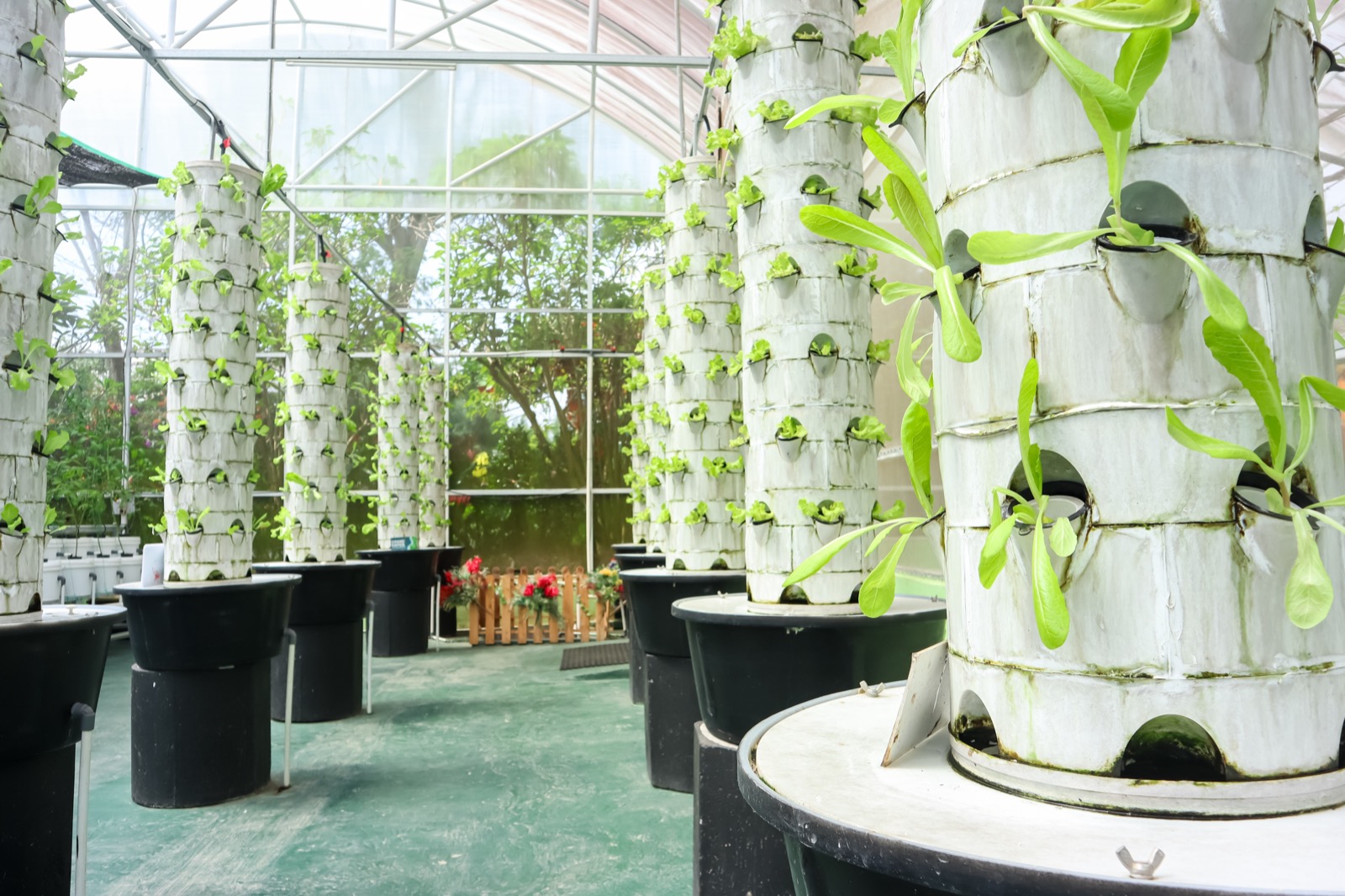
Whatever you choose to design, know that food insecurity and global hunger affects people every day. This is a worldwide problem that does not have an easy solution. Applying multiple, unique sustainable food objectives is a great place to start. The first step is educating people about how they can help with food issues in their own community. What ideas do you have for creating sustainable food resources for the future?
Want To Learn More?
Excited by the possibilities for food science? Discover other ways this technology is changing the world!
- Learn more about greenhouses and how the ones built for the ISS might be able to help humans on Earth.
- Research how to help the Earth by using climate-smart agriculture to offset the effects of climate change.
- Investigate how the closed-loop system of growing food on the ISS would help farmers on Earth to reduce their dependence on fertilizers.
- Learn how you could become a food scientist!
NGSS Standards
- MS-LS1-5: From Molecules to Organisms: Structures and Processes – Construct a scientific explanation based on evidence for how environmental and genetic factors influence the growth of organisms.
- MS-ETS1-1: Engineering Design – Define the criteria and constraints of a design problem with sufficient precision to ensure a successful solution, taking into account relevant scientific principles and potential impacts on people and the natural environment that may limit possible solutions.
- MS-ETS1-4: Engineering Design – Develop a model to generate data for iterative testing and modification of a proposed object, tool, or process such that an optimal design can be achieved.
Career And Technical Education Career Clusters
- Agriculture: This career cluster concentrates on the scientific advancement of agriscience, cultivation, processing, and distribution of agricultural products, employing advanced technologies and sustainable practices to optimize global food systems. Plant Systems involves the study and management of plant growth, soil health, and pest management, focusing on sustainable crop production for both food and goods. Agricultural Technology & Automation sites at the intersection of agriculture and technology, focusing on the design and operation of agricultural equipment and systems.
- Healthcare and Human Services: This career cluster promotes whole health in individuals and communities through a diverse array of services. This sector includes technical, mental, and therapeutic services and personal care, supported by medical and social sciences. The Physical Health sub-cluster focuses on healthcare that directly affects the physical well-being of individuals by providing medical care, conducting diagnostics, offering therapeutic services, administering pharmaceuticals, and supporting nutrition and dental health.
UN Sustainable Development Goals
- Zero Hunger: Goal 2 aims to end hunger, achieve food security and improved nutrition and promote sustainable agriculture.
Credits:
Lesson by Jennifer Swanson
Developmental Editing by Sandy Roberts
Copyediting by Erica Williams
Digital Production by Sandy Roberts

Special thanks to the ISS National Laboratory and the Center for Advancement of Science in Space™ (CASIS™) for funding this resource. Working together with NASA, the ISS National Lab aims to leverage the space station to inspire the next generation.
This resource is part of Science Friday’s Down To Earth: Space Science For Community Change program.
Educator's Toolbox
Meet the Writer
About Jennifer Swanson
Jennifer Swanson is an educator, children’s book author, and the creator and cohost of the Solve It! for Kids science podcast. She’s based in Jacksonville, Florida.










